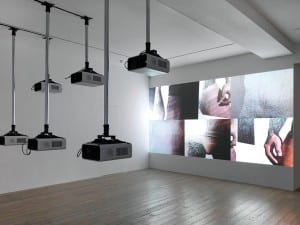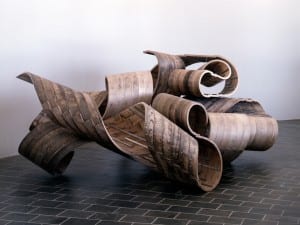At first it is hard to imagine an exhibition of large-scale, contemporary sculpture adorning the classical gardens and Italian façade of the waterfront 1920s villa that has been serving as the Sakip Sabanci Museum since 2002. Yet there is something irreverently and intriguingly appropriate about coming face-to-face with the sheer physicality of abstract form in something like Kapoor’s Double (2006) amongst the kitsch cherub garden fountains of a bygone era. Curated by Sir Norman Rosenthal and featuring a mixture of new and iconic works, Istanbul is hosting the acclaimed Indian-born British contemporary artist Anish Kapoor from until 5 January 2014 in his first major exhibition in Turkey.
In pride of place on the balcony of the grounds stands Non-Object (Pole), Kapoor’s 2008 work of stainless steel, performing precisely the very act of temporal and spatial play that the paradoxes to its chosen venue initiates. Trapping and twisting in its concave mirror surface both the viewer and the panorama of the Bosphorus, its wormhole-like presence starts off the exhibition by boldly imposing its “space-bending” will on the city’s ancient skyline. So begins the sense of hypnotic and beautiful indeterminacy this award-winning artist sustains around the question of perception for the rest of this exhibition.
Before we can enter the main exhibition, Sky Mirror (2001) demands our attention, standing sentinel just outside the villa in another stroke of curatorial skill. Previously exhibited in iconic surroundings like Kensington Gardens (2010) and the Rockefeller Center (2006), its current hilltop location at the Sabanci Museum allows it to capture a horizontal swathe of sky and sea in a concave impression. It almost challenges the assumed supremacy of our own gaze by flaunting its alternative, more comprehensive, and compact reflection of reality. Is surface, too, not as expressive of the “reality” of substance, though often underprioritised for form? Meditations like this and more in mind, moving through the plentitude of marble and alabaster works inside becomes entrancing and, as a result, mentally tiring in equal measure.
Kapoor’s well-known and celebrated pieces Yellow (1999), My Body Your Body (1993) and The Earth (1992) are there in all their mesmerising depth and starkness, frustrating and capturing the viewer in equal measure. Although already pointed out by many, it merits mention how powerfully these highlight the insufficiency of our perceptive faculties; their evasive presences, in the form of spherical voids and optically-challenging inner curvatures, seem to request we do them the justice of a more intuitive and supra-visual method of “looking”. Following this interrogation of perception, Kapoor’s attention seems to shift to the pulsations and organicism of matter with his later sculptures of onyx and alabaster.
The natural veins and warm pink tones of this rock, combined with the globular smoothness of Kapoor’s design, make his onyx sculptures like Imminence (2000) and Eight Eight (2004) distinctly more embryonic, bodily and sensual than the geometric precision of alabaster works such as Five Hollows (2012). Almost capturing the natural transformations of matter in a perpetual movement of creation too gradual for us to detect, the technical precision of these hefty pieces strikes only secondarily. That immediacy of viscerality also exemplifies Archeology and Biology (2007); this long, vertical wall-chasm rounds off the exhibition with the impression that only (non-)matter itself can lay claim to being the ultimate mystery of expression.
In a press conference attended by Rosenthal and Kapoor prior to the opening of the exhibition in September, Rosenthal emphasised that “what is especially remarkable about Anish Kapoo=r’s abstract stone works, which form the focus of the exhibition, is that they have their own specific ways of defining infinities and the concepts of time”; however, the historical and cultural suggestiveness of its chosen venue, which houses a rich permanent collection of Ottoman and Western Orientalist art, arguably entwines the isolated temporality of Kapoor’s works with a layered, connected spatiality. Their “redefinition of infinities and the concepts of time” occurs within surroundings that encapsulate the variety of “times” Istanbul’s own socio-historical past has seen, making Kapoor’s creations all the more expressive: not so much for their isolation, but – perhaps ironically, considering the prominence of voids in his pieces – for their far weightier intrusion and self-inclusion upon the precise “time” of the viewers themselves.
Anish Kapoor in Istanbul, until 5 January, Sabancı University Sakıp Sabancı Museum, Sakıp Sabancı Cad. No:42, Emirgan 34467, İstanbul.
Sarah Jilani
Credits
1. Sky Mirror, 2010, Stainless steel, Diameter: 290 cm, courtesy The artist and Lisson Gallery.




